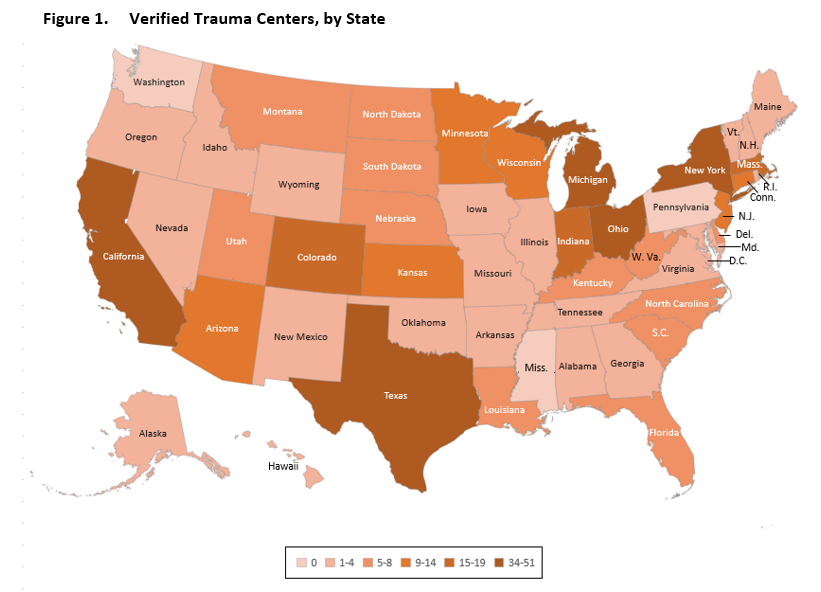


Outcomes According to Level of Trauma Center Designation Adjusted odds ratios with 95% confidence intervals were calculated from the regression analysis and statistical significance was set at P < 0.05. Multivariate logistic regression models were created to examine the effect of ACS designation on mortality after adjusting for the following variables, which were identified after the univariate analysis: age, gender, injury mechanism (blunt or penetrating), injury severity score, and hypotension on admission (systolic blood pressure <90 mm Hg). Those variables with P value <0.2 were entered into the multivariate analysis. Univariate analysis was performed, which included age, gender, mechanism of injury, first Glasgow Coma score, first systolic blood pressure, first respiratory rate (assisted or unassisted), ISS, and AIS scores for head, chest, abdomen, and extremity. Univariate statistical analysis was performed using the unpaired Student t test or Mann-Whitney rank-sum test for continuous variables and chi-squared with Yates correction for categorical variables.

For the purposes of the study, we defined severe functional disability as a total FIM score (FIMtot) of less than 9. The total FIM score is the sum of the scores for the 3 areas with a maximum possible score of 12 indicating complete functional independence at discharge. Patients are given a score for each area ranging from one (requires total assistance) to 4 (able to perform activity independently). This rating system evaluates the degree of functional disability in 3 major areas: feeding, locomotion, and expression. The degree of functional disability among survivors at discharge was assessed using the functional independence measure (FIM) score. Outcomes (mortality, intensive care unit stay, and severe disability at discharge) were compared among level I and II trauma centers and among centers within the same level designation but different volumes of severe trauma (15 per year).
#TRAUMA CENTER LEVELS CALIFORNIA WINDOWS#
The following data were included in a computerized spreadsheet and analyzed using SPSS 12.0 Windows (SPSS Inc, Chicago, Illinois) for the purpose of the study: age gender mechanism of injury (blunt or penetrating) hypotension on admission (systolic blood pressure ≤90 mm Hg or >90 mm Hg) abbreviated injury score (AIS) for head, chest, abdomen, and extremities injury severity score (ISS) severe liver trauma (International Classification of Diseases, 9th Revision codes 864.04, 864.09, 864.14, 864.19) penetrating cardiac injuries (861.03, 861.12) aortic injuries (901.0, 902.0) vena cava injuries (901.2, 902.0) iliac vascular injuries (902.53, 902.54, 902.50) quadriplegia (806.01, 806.06, 806.11, 806.16) and complex pelvic fractures (808.43, 808.53). The study included trauma patients older than 14 years of age who were alive on admission to the hospital and had at least one of the following severe injuries: aortic, vena cava, iliac vessels, grade IV/V liver injuries, penetrating cardiac injuries, quadriplegia, or complex pelvic fractures ( Table 1) during the period 1996 through 2003.

The number of admissions of patients with an ISS greater than 15 per year was also collected for each participating center. The ACS trauma level designation for each facility was categorized as level I, level II, or other. In addition to the patient-specific data, information for each admission was collected regarding the treating hospital. The database contains information on patient demographics, prehospital care, diagnoses and injury severity scoring, inpatient care and complications, as well as outcomes. This ongoing project represents the largest trauma registry ever assembled and currently contains over one million prospectively collected patient records. Overall, level I centers had significantly lower mortality (25.3% vs 29.3% adjusted odds ratio, 0.81 95% confidence interval, 0.71–0.94 P = 0.004) and significantly lower severe disability at discharge (20.3% vs 33.8%, adjusted OR, 0.55 95% CI, 0.44–0.69 P 15 (<240 vs ≥240 cases per year) had no effect on outcome in either level I or II centers.ĭata for this study was obtained from the National Trauma Data Bank (NTDB), which is maintained by the American College of Surgeons. A total of 12,254 patients met the inclusion criteria.


 0 kommentar(er)
0 kommentar(er)
